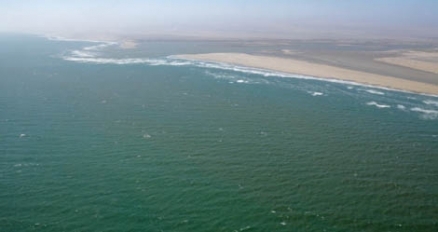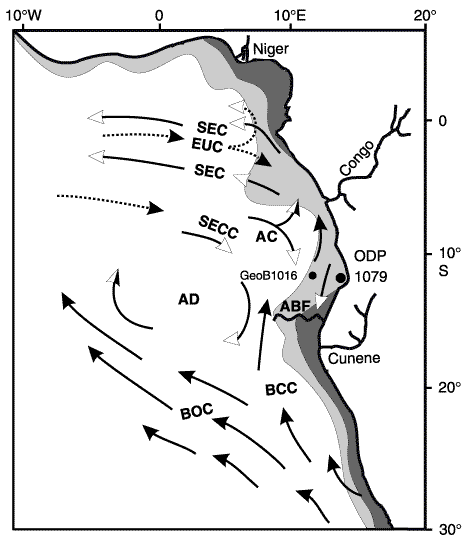Angola Dome
The Angola Dome is a small cyclonic ocean gyre, centered near 10o S and 9oE, driven by the South Equatorial Undercurrent in the eastern Atlantic Ocean. It is called a dome due to the elevation or doming of the thermocline in the middle of the gyre. This is distinct from the larger gyre that incorporates the Angola Current.
Angola Current
The Angola Current itself is the eastern part of a cyclonic gyre centered around 1oS and 4oE that is driven by the South Equatorial Countercurrent in the Atlantic Ocean. This subsurface circulation gyre extends from just below the surface to around 300 meters in depth with velocities of about 0.5 meters per second in the section nearest the African coast. The confluence between this southward flowing current and the northward flowing Benguela Current near 16 degrees Southern latitude off the African coast is called the Angola-Benguela Front.
Ecology
The Angola Dome is instrumental in altering the interface between the Angola Current and Benguela Current. This contact zone changes over time, with a measurable change in location of the Angola-Benguela Front transpiring over a time frame of a few years to decades. The marine organisms that thrive in the two current zones have a dramatically different composition due to the temperature differential within the two currents; the Benguela Current is the cooler of the two.
Besides the temperature differential, there are some marked biogeographical consequences of the movement of the Angola-Benguela Front. For example, at the mouth of the Kunene River, which divides Angola from Namibia, there is presently a trapped ecosystem, which has formed disjunctive populations of a number of marine organisms, most notably Leatherback Turtles.
Angola-Benguela Front
The Angola-Benguela Front (ABF) is a oceanic front caused by the confluence of the southward flowing Angola Current and the northward flowing Benguela Current presently near 16oS off the African coast. This can be identified in the temperature of the upper 50 metres (m) and in the salinity to at least 200 m in depth. The ABF varies somewhat in its exact location depending upon the regional meteorology, but is generally in the vicinity of the border between Angola and Namibia at the mouth of the Kunene River.
Further Reading
- Peter Saundry (Lead Author); C Michael Hogan PhD. (Topic Editor) "Seas of the world". In: Encyclopedia of Earth. Eds. Cutler J. Cleveland (Washington, D.C.: Environmental Information Coalition, National Council for Science and the Environment). [[published in the Encyclopedia of Earth December 8, 2009; Last revised Date August 19, 2011; Retrieved August 24, 2011 <http://www.eoearth.org/article/Seas_of_the_world?topic=49523>
- R. G. Peterson and L. Stramma. Upper-level circulation in the south atlantic. Prog. Oceanog., 26:1–73, 1991.
- Matthias Tomczak and J. Stuart Godfrey. Regional Oceanography: An Introduction. Pergamon, 1994.
- Pérez, M.E., Charles, C.D., and Berger, W.H., 2001. Late Quaternary productivity fluctuations off Angola: evidence from benthic foraminifers, Site 1079]. In Wefer, G., Berger, W.H., and Richter, C. (Eds.), Proc. ODP, Sci. Results, 175 [Online].

